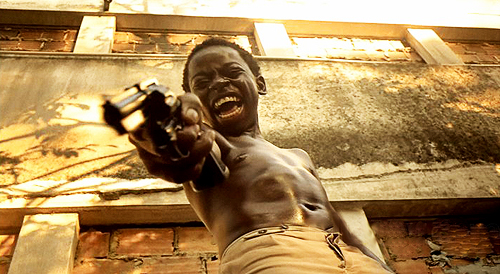
The depicted violence in Cidade de Deus (City of God, Meirelles & Lund) – whether within the city or within its characters – gets explained in a variety of different ways but is ultimately presented as something beyond comprehension or escape. While at some points motives are suggested, they appear insufficient to account for the pervasiveness and level of violence. Additionally, all articulated alternatives to violence get eventually undermined.
Explicit violence can be an aesthetic tool; it can be shocking, educational or simply entertaining. How much responsibility does a filmmaker have towards society when depicting violence in a film?
Fernando Meirelles’ and Kátia Lund’s City of God is narrated by a boy growing up in one of Rio’s slum towns. These favelas exist outside Rio de Janeiro’s popular image and outside the laws. The story of the City of God is built around the stories of its gang leaders and the youth of the favela are connected through constant acts of violence. The entire plot is driven by acts of violence; though not only of a physical nature such as murder or rape.
Early in the film, crime is shown as a direct response to poverty. The poor’s attempts to earn a living are obstructed by the system, as when the police forces Rocket (the main character) to abandon the fish he is selling. Also, violence is presented as something almost exclusively male. In the film, women’s bodies appear to be just another place for the men to be violent. As one of the Runts says, “I smoke, I snort. I’ve killed and robbed. I’m a man.”, violence makes men out of boys and seems to define manhood.

The film aims to make those uncomfortable who seek some kind of silver lining in the narrative. With one hand Meirelles and Lund hint at alternatives to the on-screen (and off-screen) violence, whit the other they immediately disempower those alternatives. They break with expectations by presenting no viable moral choice. City of God does not legitimize violence but neither does it condemn it. The film’s fatalism (that cannot only be ascribed to the main character) is its main message to the audience.
By destroying the illusion of escape through religion, work, ports or education and denying the audience satisfactory motives for the depicted violence, City of God tries to depict a realistic image of the favela.
I conclude that the depicted violence in City of God serves a clear purpose. The film is far more than just entertaining – in has a message: it tries to explain how the violence works and why there is violence in certain places. Combined with its rapid editing, the constantly moving handheld camera that at some points moves seemingly unmotivated and the peculiar shots through gaps and from under objects that make it feel like “real” war footage, the film sucks the audience in far deeper than the average story.

